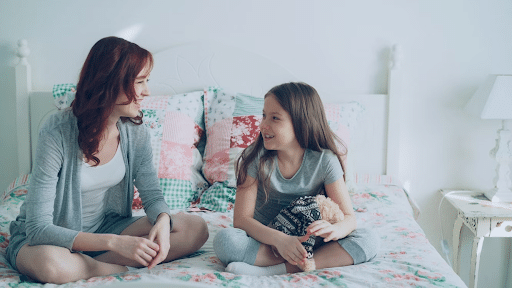Let’s be honest: even as adults, most of us don’t like talking about pee and poop. It feels awkward, a little embarrassing, and sometimes even “off-limits.” Now imagine how it feels for a child who is already struggling with leaking, bedwetting, or constipation — or for their parents, who may feel guilty or frustrated.
This silence is one of the biggest reasons pediatric pelvic floor dysfunction goes undiagnosed and untreated for so long. Kids and parents don’t bring it up. Therapists don’t always know how to ask. And so the cycle continues, as families bounce between providers as kids keep suffering in silence, and therapists feel like something is missing.

Here’s the good news: you, as a pediatric therapist, are uniquely positioned to break this silence. When you learn how to talk about bladder and bowel health in a way that feels safe and supportive, you create opportunities for meaningful changes in the lives of your pediatric patients.
Why Families Don’t Bring Up Bowel And Bladder Issues
You’ve probably seen this in your clinic: a child comes in for pain or motor delays, but weeks later, you discover they’re also dealing with constipation or incontinence. Why didn’t the family mention it sooner?
There are a few common reasons:
- Embarrassment: Parents feel ashamed that their child isn’t “normal,” and kids may feel dirty or “bad.”
- Misinformation: Families are often told by well-meaning providers that kids will “grow out of it,” so they don’t bring it up. They may have also encountered information online and feel as though they must/have to manage it on their own.
- Fear of judgment: Parents may worry you’ll think they’re neglectful. Kids may fear being teased or punished.
- Not knowing it’s relevant: Many parents don’t realize that pelvic health can be addressed with therapy. They assume you only work on motor skills, not bladder or bowel issues.
The result? Families keep quiet. And unless you ask the right questions, you may never know these challenges exist.

Common Barriers Pediatric Therapists Face With Bladder and Bowel Conversations
Talking about bladder and bowel issues isn’t only difficult for families. Therapists often avoid these conversations as well.
Maybe you’ve felt one of these yourself:
- “I don’t want to make the parents uncomfortable.”
- “I don’t even know what questions to ask.”
- “What if they ask me for help and I don’t know what to do?”
The reality is, most therapy programs don’t provide pelvic floor training for pediatrics. You may have heard a quick mention about it in school. But without adequate training and the proper tools, it makes sense that you’d avoid the conversation.
But here’s the thing: these issues won’t go away just because we don’t talk about them. Kids are still suffering. Families are still looking for answers. And you’re often the professional they trust most.
When bladder and bowel issues remain unspoken, the consequences for kids can be huge:
- Emotional distress: Kids may develop shame, anxiety, or low self-esteem.
- Social withdrawal: They avoid sleepovers, sports, or school activities for fear of leaking.
- Physical complications: Chronic constipation can lead to pain, encopresis, or even hospital visits.
- Family stress: Parents often feel helpless or frustrated, which can strain relationships at home.
From your perspective as a therapist, silence means missed opportunities. You might be treating a child for posture or functional strength without realizing that their constipation or incontinence is part of the picture.

Break The Silence On Pediatric Pelvic Floor Dysfunction
The first step is simple: bring it up. Families often need permission to talk about bladder and bowel challenges. When you normalize the conversation, you take away the shame.
Here are a few strategies that work:
1. Normalize It From the Start
When you’re doing your intake or history, include questions like:
- “How often does your child have bowel movements?”
- “Do they ever have any bowel or bladder leaking, either during the day or at night?”
- “Do they ever avoid using the bathroom at school?”
By asking every family these questions, you make it clear that bladder and bowel health is just another part of pediatric therapy, nothing unusual or shameful. It also creates a habit for you, and asking becomes easier and easier over time.
2. Use Kid-Friendly Language
Use simple, clear language when asking kids about their bowel and bladder habits:
- “Does it ever feel like your pee comes out before you’re ready?”
- “Does your tummy hurt a lot, like it’s full or stuck?”
- “Do you ever feel like you need to go potty, but then nothing happens?”
This helps kids feel comfortable and understood, rather than confused or singled out.
3. Create a Safe Environment
Make sure families know there’s no judgment. You might say:
- “Lots of kids have challenges with pee and poop. You’re not alone.”
- “This isn’t your fault, and it isn’t your child’s fault.”
- “You haven’t done anything wrong. Sometimes our bladders or bowels just need some help doing what they’re supposed to do.”
When parents hear this, they often relax. When kids hear it, they open up.
4. Be Ready With Next Steps
This is where training comes in. When you know how to assess and treat pediatric pelvic floor dysfunction, you can move from conversation to action. Families leave your clinic feeling hopeful instead of dismissed.

Why Pediatric Pelvic Floor Therapy Matters
When you become comfortable talking about pee and poop, you immediately stand out. Families remember the therapist who asked about the hard stuff, the one who didn’t shy away.
Breaking the silence allows families to finally feel relief, knowing they can talk openly about what has been bothering them, sometimes for years. Children feel understood rather than ashamed. In the process, you often uncover root causes for problems that may have seemed unrelated initially.
Over time, your practice can grow organically, as parents share their experiences and recommend you to others. By initiating these conversations, you change lives in ways that extend far beyond individual therapy sessions.
Of course, conversations alone aren’t enough. Once you open the door, you need to know what to do next. That’s where most therapists hit a wall. You can ask the questions, but when families say “yes, that’s happening,” you don’t want to be stuck without further skills.
That’s why specialized training in pediatric pelvic floor therapy matters. With the right tools, you’ll be able to:
- Identify dysfunction when you see it.
- Assess bladder and bowel dysfunction with confidence.
- Teach effective strategies for kids.
- Collaborate with families to build healthy habits.
This is exactly what we cover in Peds Level 1 – Treatment of Bowel and Bladder Disorders, so you can feel confident having these conversations and turning them into action. This course will be live, virtually on October 25-26, 2025!
You don’t have to avoid the “taboo” topics anymore. You don’t have to feel awkward or unsure. With the right training, you can be the therapist who breaks the silence, starts the conversations, and makes a difference in the lives of kids and families.
Reference:
Timmerman ME, Trzpis M, Broens PM. Prevalence of Defecation Disorders and their Symptoms is Comparable in Children and Young Adults: Cross-Sectional Study. Pediatr Gastroenterol Hepatol Nutr. 2021 Jan;24(1):45-53. https://doi.org/10.5223/pghn.2021.24.1.45
